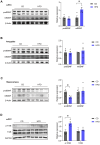A Four-Week High-Fat Diet Induces Anxiolytic-like Behaviors through Mature BDNF in the mPFC of Mice
- PMID: 38672038
- PMCID: PMC11048392
- DOI: 10.3390/brainsci14040389
A Four-Week High-Fat Diet Induces Anxiolytic-like Behaviors through Mature BDNF in the mPFC of Mice
Abstract
The effect of a high-fat diet (HFD) on mood is a widely debated topic, with the underlying mechanisms being poorly understood. This study explores the anxiolytic effects of a four-week HFD in C57BL/6 mice. Five-week-old mice were exposed to either an HFD (60% calories from fat) or standard chow diet (CD) for four weeks, followed by cannula implantation, virus infusion, behavioral tests, and biochemical assays. Results revealed that four weeks of an HFD induced anxiolytic-like behaviors and increased the protein levels of mature brain-derived neurotrophic factor (mBDNF) and phosphorylated tyrosine kinase receptor B (p-TrkB) in the medial prefrontal cortex (mPFC). Administration of a BDNF-neutralizing antibody to the mPFC reversed HFD-induced anxiolytic-like behaviors. Elevated BDNF levels were observed in both neurons and astrocytes in the mPFC of HFD mice. Additionally, these mice exhibited a higher number of dendritic spines in the mPFC, as well as upregulation of postsynaptic density protein 95 (PSD95). Furthermore, mRNA levels of the N6-methyladenosine (m6A) demethylase, fat mass and obesity-associated protein (FTO), and the hydrolase matrix metalloproteinase-9 (MMP9), also increased in the mPFC. These findings suggest that an HFD may induce FTO and MMP9, which could potentially regulate BDNF processing, contributing to anxiolytic-like behaviors. This study proposes potential molecular mechanisms that may underlie HFD-induced anxiolytic behaviors.
Keywords: BDNF; anxiolytic-like behaviors; dendritic spine; high-fat diet; mPFC.
Conflict of interest statement
The authors declare no conflicts of interest.
Figures






References
-
- Chrobok L., Klich J.D., Sanetra A.M., Jeczmien-Lazur J.S., Pradel K., Palus-Chramiec K., Kepczynski M., Piggins H.D., Lewandowski M.H. Rhythmic neuronal activities of the rat nucleus of the solitary tract are impaired by high-fat diet-implications for daily control of satiety. J. Physiol. Lond. 2022;600:751–767. doi: 10.1113/JP281838. - DOI - PubMed
-
- de Noronha S.R., Campos G.V., Abreu A.R., de Souza A.A., Chianca D.J., de Menezes R.C. High fat diet induced-obesity facilitates anxiety-like behaviors due to GABAergic impairment within the dorsomedial hypothalamus in rats. Behav. Brain Res. 2017;316:38–46. doi: 10.1016/j.bbr.2016.08.042. - DOI - PubMed
Grants and funding
- 81971234/National Natural Science Foundation of China
- IRT_16R37/the Program for Changjiang Scholars and Innovative Research Team in University
- 2018B030340001/the Key Area Research and Development Program of Guangdong Province
- 2018B030334001/the Key Area Research and Development Program of Guangdong Province
- 202007030013/the Science and Technology Program of Guangzhou
LinkOut - more resources
Full Text Sources
Miscellaneous

